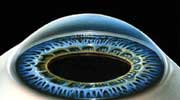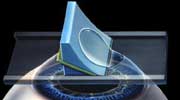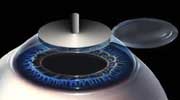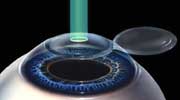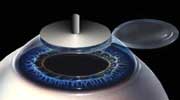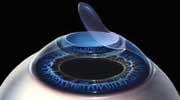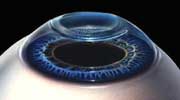Intraoperative corneal cooling reduces pain after surface laser procedures, surgeons say
Reduced edema and reduced cellular necrosis were observed with confocal microscopy.
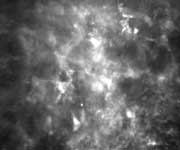 Stroma 1 day after standard PRK procedure without corneal cooling. Edema and cellular damage are seen. Keratocytes are not clearly visible.  Stroma 1 day after PRK procedure with corneal cooling. Less edema and less cellular damage are seen. Images: Fortunato M |
Intraoperative corneal cooling can decrease the incidence and the intensity of postoperative pain after PRK, laser epithelial keratomileusis and epi-LASIK procedures, according to surgeons who are using the method.
Interest in surface laser procedures has been revived recently. Some surgeons have noted that these procedures, which do not depend on creation of a microkeratome flap, can have no flap-related complications. In addition, some surgeons have suggested that procedures without a flap may be less prone to induction of optical aberrations and postoperative dry eye.
When Massimo Camellin, MD, described the idea of creating an epithelial flap in LASEK rather than a stromal flap, one of his rationales was that this surface procedure reduced some of the major drawbacks of PRK — the induction of postoperative pain and stromal haze. Dr. Camellin reported a variable degree of pain in some patients after his new procedure, but in fewer cases than with PRK.
Epi-LASIK, described by Ioannis Pallikaris, MD, occasionally caused some pain as well. Epi-LASIK involves the mechanical separation of the epithelial sheet.
“Subjective symptoms above the threshold of discomfort were reported by 16% of our patients within the first 2 hours after the treatment,” said Vikentia Katsanevaki, MD, who works with Prof. Pallikaris.
No haze, less pain
Some have proposed that pain and haze formation after photoablation procedures seem to be due to an increase in corneal temperature. Reports in the early 1990s proposed that intraoperative lowering of the corneal temperature with cold balanced salt solution could substantially decrease pain and haze after PRK. However, the corneal cooling procedure for PRK never caught on, and LASIK soon became a more popular procedure because postoperative pain was reduced in comparison to PRK.
Four years ago, Michele Fortunato, MD, and colleagues Istvan Molnar and Riccardo Maggi attempted to apply corneal cooling to both PRK and LASEK using cold metal shields. Results were encouraging, and the technique was standardized and patented in February 2000.
“We have performed 1,307 refractive surgery procedures with this method of corneal cooling. We operated on patients with myopia ranging between –1.5 D and –20 D (903 eyes), hyperopia between +1.5 D and +4.5 D (89 eyes) and astigmatism between —4.5 D and +4.5 D (315 eyes). We’ve had no case of postoperative haze, and pain was never greater than 2 in a score of 1 to 4,” Dr. Fortunato said.
Patients were able to keep their eyes open in the early postoperative hours and carry out their normal daily activities in the following days, he said.
Cooling shields
|
Images: Fortunato M |
Dr. Fortunato said that he performs corneal cooling by applying a small concave shield to the cornea. The instrument has been sterilized and refrigerated at a temperature of –3° to –5° C.
“The shield is placed on the cornea with plastic forceps for 40 seconds just before laser photoablation,” he explained. “After laser treatment, the cooling process is repeated with a second refrigerated shield, which can again be concave for hyperopic eyes or convex for myopic eyes, to better adapt to the new corneal curvature.”
In LASEK, the epithelial flap is then repositioned, and a bandage contact lens is applied. In PRK, surgery ends with the application of the contact lens.
The shields are made of a chromium-plated metallic material and have a variable diameter of 5 mm to 7 mm, depending on the ablation profile used. To prevent heat transmission from the surgeon’s hands, the concave shield has a small knob on the external surface for grasping with forceps, and the convex instrument has a plastic handle that allows it to be held in position on the flattened cornea after photoablation.
The bandage contact lens is removed 4 to 5 days after surgery. Postoperatively, antibiotic and nonsteroidal anti-inflammatory drops are administered for 4 to 5 days, and hyaluronic acid drops are used for 3 to 6 months.
Epi-LASIK
In Dr. Camellin’s original LASEK technique, the epithelial flap is separated by treating the surface with a 20% alcohol solution. Epi-LASIK employs the alternative of mechanical separation of the epithelial sheet. According to Prof. Pallikaris, this automated procedure is easier to perform and more predictable; he also said that it maintains tissue viability by avoiding the toxic effect of alcohol.
After he observed that epi-LASIK, like LASEK, was not completely pain-free, Prof. Pallikaris and colleagues designed a prospective, randomized, double-blind study to evaluate corneal cooling as a pain-reduction strategy.
“We evaluated the clinical effects of intraoperative corneal cooling during the early postoperative clinical course of the procedure. Twenty patients underwent bilateral simultaneous epi-LASIK treatment for low myopia. They were randomized to receive intraoperative corneal cooling with chilled (balanced salt solution) in one eye, whereas the fellow eye received standard treatment and served as control,” said Dr. Katsanevaki.
Epithelial separation was performed using the Centurion Epi-Edge epikeratome. (The Centurion device was marketed by CIBA Vision at the time of the study. It was recently acquired by Norwood Abbey Ltd.)
Patients were followed daily until re-epithelialization was complete. They answered a questionnaire evaluating postoperative pain every 2 hours during the first postoperative day and once daily from day 1 until the removal of the contact lens.
The results of the study, which are under review to be published, showed that the mean pain scores of the study group were either equal to or lower than those of the control group. Mean pain scores remained below the threshold of discomfort in both groups at all intervals during follow-up. The difference of subjective mean pain scores between the two groups was statistically significant within the first 2 hours after the procedure.
“Our results suggest that intraoperative corneal cooling further decreases the incidence as well as the intensity of postoperative pain or discomfort,” Dr. Katsanevaki said.
Confocal microscopy
Dr. Fortunato has adopted epi-LASIK. The technique, he said, combines the advantages of LASIK and LASEK and eliminates their disadvantages. He uses the Epitome Epi-LASIK system (Gebauer) to perform the epithelial flap.
“The viability and integrity of the mechanically separated epithelial sheet guarantees perfect stromal protection, faster recovery and better postoperative visual acuity results,” he said.
These results are enhanced by intraoperative corneal cooling, which significantly reduces pain, he said.
“I think I’ve found the perfect combination to make my refractive surgery procedures safe, effective and comfortable for the patient,” he said.
The effects of corneal cooling on the anterior stroma were recently demonstrated with confocal microscopy by Leonardo Mastropasqua, MD, and Mario Nubile, MD, using Nidek Confoscan 3 technology.
“We compared the images of the anterior stroma 24 hours after PRK in eyes which had or had not received the corneal cooling treatment,” said Dr. Nubile. “The surgical trauma induced by photoablation was clearly visible in both cases, but in the eyes where Dr. Fortunato’s cooling shields were applied there was less edema, and undamaged keratocytes were visible on the surface. This demonstrates that corneal cooling reduces inflammation and cellular apoptosis, which accounts for the reduction of haze formation and pain.”
For Your Information:
- Ioannis Pallikaris, MD, can be reached at the University of Crete, School of Medicine, Department of Ophthalmology, P.O. Box 1352, 71110 Heraklion Crete, Greece; +30-81-392-868 or +30-81-392-351; fax: 30-81-54-20-94; e-mail: pallikar@med.uoc.gr.
- Michele Fortunato, MD, can be reached at Prima-vista Microsurgery Center, Via Sicilia 43, Roma, Italy; +39-06-35451414; fax: +39-06-35344596; e-mail: micfortunato@hotmail.com.
- Vikentia Katsanevaki, MD, can be reached at the University of Crete, School of Medicine, Department of Ophthalmology, P.O. Box 1352, 71110 Heraklion Crete, Greece; +30-81-371800; fax: +30-81-394653; e-mail: vikatsan@med.uoc.gr.
- Leonardo Mastropasqua, MD, and Mario Nubile, MD, can be reached at Unità Ottica Fisiopatologica, Ospedale Via Vestini, 66013 Chieti Scalo, Italy. phone/fax: +39-08-71358794; e-mail: mastropa@phobos.unich.it or nunu126@hotmail.com.
- Michela Cimberle is an OSN Correspondent who regularly covers ophthalmology in European countries.

